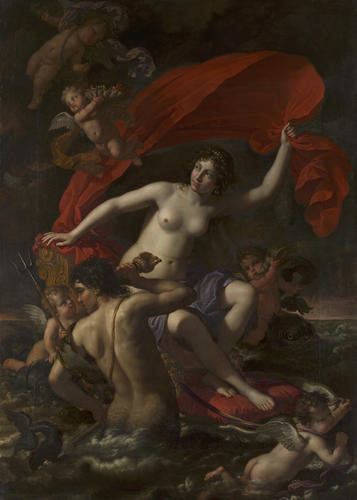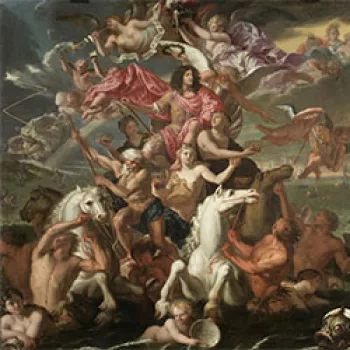The Triumph of Galatea 1677-78
Oil on canvas | 225.3 x 161.8 cm (support, canvas/panel/stretcher external) | RCIN 407151
-
The Bolognese artist Benedetto Gennari trained in the studio of his uncle, Giovanni Francesco Barbieri, known as Guercino. In 1672 Gennari travelled to Paris to seek the patronage of Louis XIV. He was favourably received and during his 16 months there is recorded as having painted 15 pictures. One of these, Diana and Endymion, was intended for the Duc de Richelieu, but was never delivered, and Gennari subsequently presented it to Charles II as an introductory gift, after arriving at court in September 1674.
During his 16 years in England, Gennari worked for both Charles II and James II, receiving a yearly stipend of £500. He kept a chronological list of his prodigious output, including 102 paintings during the reign of Charles II, 35 during the reign of James II. He painted a further 30 works for James II following the Glorious Revolution, having joined the court in exile at Saint-Germain-en-Laye in 1689.
Gennari was particualrly popular with Catholics at court, including Catherine of Braganza, for whom he painted a number of altarpieces for the private chapels at Whitehall, St James's Palace, Windsor Castle and Somerset House. He also painted numerous portraits, including Queen Catherine 'seated on the shore, in a melancholy attitude, sighing over [her] departure from Lisbon', and Louise de Kéroualle with her son in the guise of Cupid.
This canvas comes from a set of four large-scale mythological scenes commissioned by Charles II, which were hung in the King's Dining Room at Windsor Castle 'with three other pictures, one by Tintoretto, the other two, they say, by Titian'. All represent love stories from Ovid's Metamorphoses. The beautiful sea-nymph Galatea sits naked upon a chariot, borne across a raging sea by winged putti, some of whom are riding dolphins. The Triumph of Galatea was a popular subject in seventeenth-century painting, inspired by Raphael's fresco treatment of it in the Villa Farnesina. Book XIII of Ovid's Metamorphoses tells how Galatea loved the youth Acis, but was vainly loved by the one-eyed giant Polyphemus. After chancing upon the young lovers together, the jealous Polyphemus threw a boulder at Acis and killed him. Here Galatea is pictured fleeing from Polyphemus, and so the painting is not properly a 'triumph'. Nevertheless, there is an air of triumph about Galatea's pose, and the composition resembles Raphael's fresco which shows Galatea's apotheosis, and celebrates beauty and the enduring power of love.
Gennari's mytholgoical paintings for Charles II advertised both the patron's and the artist's knowledge of classical literature, but they also provided the opportunity to depict four beautiful, semi-nude female protagonists in a variety of poses.
Signed bottom left: GENNARI.
Text adapted from Charles II: Art and Power, London, 2017.Provenance
Painted for King Charles II and recorded as a set of four in the King's Eating Room at Windsor Castle in 1688 (nos 759-62)
-
Medium and techniques
Oil on canvas
Measurements
225.3 x 161.8 cm (support, canvas/panel/stretcher external)
243.6 x 181.4 x 7.8 cm (frame, external)
Category
Object type(s)









